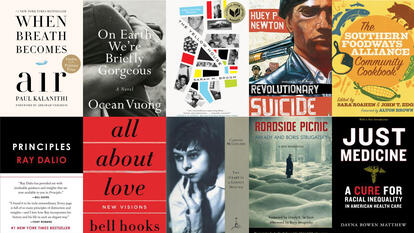In New Book, Professors Chart a History of Life Writing as a Means to Address Gender and Racial Injustice

In January 2018, Rachael Denhollander, the first former athlete to publicly accuse Larry Nassar of sexually assaulting her when he served as team physician for Michigan State University, USA Gymnastics, and the U.S. Olympic gymnastics team, asked at the conclusion of Nassar’s trial, “How much is a little girl worth?” Her testimony, alongside over 150 other victim accounts, resulted in Nassar’s conviction after more than 30 years of molesting patients under the guise of treating them for sports injuries.
In their new book, Witnessing Girlhood: Toward an Intersectional Tradition of Life Writing, Leigh Gilmore, distinguished visiting professor of women’s and gender studies at Wellesley, and Elizabeth Marshall, associate professor of education at Simon Fraser University, explore the narrative strategies used by women who experienced trauma as children and have long been silenced or ignored, to tell their stories and have those stories heard.
Gilmore and Marshall write that the recent Nassar trial fits in with a tradition of adults, and in particular, women of color, who use the figure of the child witness as a way to expose injury and seek justice. By analyzing diverse forms of self-representation, including slave narratives, contemporary feminist comics, children’s picture books, stand-up comedy, and trans narratives, the authors chart a history of how women from the 19th century on have written about their lives in order to transform conditions of suffering and injustice into accounts that will elicit ethical responses.
Below, Gilmore talks about some of the themes addressed in the book.
Q: You use the term “life writing” rather than memoir or autobiography. Why?
Leigh Gilmore: “Life writing” is an umbrella term that includes diverse autobiographical forms. We have a chapter on children’s picture books, for example, and one on the memoir boom of the 1990s that also analyzes Hannah Gadsby’s solo performance Nanette. We connect slave narratives to Latin American testimonio and to feminist comics and graphic memoir in order to demonstrate how frequently and powerfully women, and trans and nonbinary writers, use the self-representation of childhood and adolescence to disrupt norms of silencing and connect with readers.
Q: What inspired you to examine life writing, particularly by women of color, that focuses on narratives of traumatized girlhood?
Gilmore: My co-author, Elizabeth Marshall, and I were struck by a particular moment in the 1990s when there seemed to be a new interest in the lives of girls in crisis, especially in the Global South. The Fourth World Conference on Women in Beijing in 1995, and humanitarian projects like Nicholas Kristof and Sheryl WuDunn’s Half the Sky foundation and Nike’s Girl Effect all previewed a steady stream of resolutions addressing education, gender violence, and the health of women and girls. At the same time, we noticed that women themselves were rarely sought as authorities to frame solutions, even though they had often already done so.
This struck us as strange: Who would know more about traumatized girlhood than the women those girls grew up to be? Because the focus on girls obscures women as political agents, we wondered if there might be a tradition of women writing about their childhoods, framing their authority through this experience, and representing the impact of violence and their analysis of it. Are habits of not paying attention to women so entrenched that a body of knowledge in the form of self-representation is hiding in plain sight? This is precisely what we found in life writing by women of color about violence experienced in childhood, and in their choice to use life narrative strategically to persuade diverse and distant audiences to see them as credible witnesses rather than rescue targets. The exemplary origin to this tradition is Harriet Jacobs’ Incidents in the Life of a Slave Girl. With her work as a starting point, we trace the recurrence of a mode of life writing that enlists the reader as an ethical witness and is centrally concerned with race, gender, and justice.
Q: What do you hope readers will take away from the book?
Gilmore: We hope readers will appreciate a tradition of life writing that centers the innovations—political and imaginative—of women of color, who, from the 19th century forward, offered narratives of girlhood to manage the potential aversion, disidentification, or apathy of dominant audiences. Autobiographical writing by women of color has been tremendously influential in developing the testimonial dimension of life writing. Their influence on the ethics of responding to personal stories is widespread and profound.
Q: What connections do you see between past and present self-representations of traumatized girlhood?
Gilmore: In connecting events and cases across different time periods, forms, and places, we found recurring strategies and figures. For example, the use of what we call a “trope of accompaniment” offers a way to retell the story of childhood trauma without retraumatizing the author or performing that retraumatization for readers. Rather than present a narrative that immerses the reader in the author’s girlhood, the adult narrator reframes the trauma, explains it, offers knowledge she did not have access to at the time, and otherwise ensures that, unlike the vulnerability and isolation she experienced in life, in the narrative, she will accompany her younger self in order to make a point about trauma and justice.
Another key finding that haunted us was the regularity with which women could go from being remembered to forgotten, even rediscovered and re-forgotten. Neither fame nor significance protects against the power of misogyny and racism to distort women’s autobiographical witness. Girls are often abused and doubted, even as they are held up as figures warranting care and protection. The doubling of authority and credibility through reference to childhood experience by adult women is often effective in compelling audiences to engage ethically, we think, because it exposes the gap between reality and myth. Once this gap opens up, then statutes of limitations, nondisclosure agreements, and other mechanisms for preventing survivor testimony from gaining a hearing are also exposed, and with them, the larger institutional structures that collude in violence and the men who benefit. The bias toward the myth that “we” would protect innocent victims, especially children, is stubborn. The reality is more complicated: “We” often do not protect the most vulnerable, especially children and women of color. And we too often protect those who abuse them.
Gilmore also writes publicly on feminist topics and the #MeToo movement for international and national media. You can read her latest article about the connections between migrants in detention camps and E. Jean Carroll in WBUR’s Cognoscenti.



